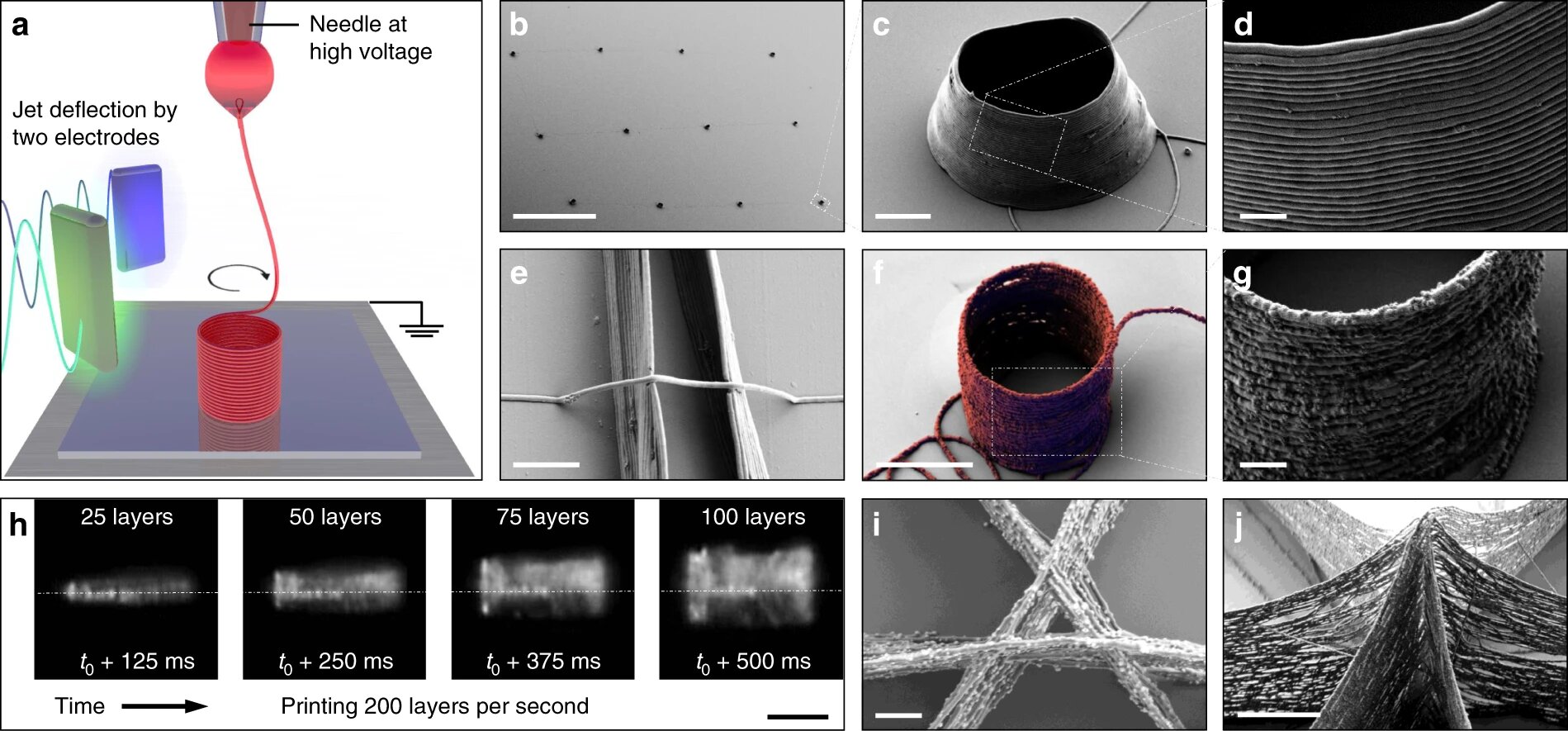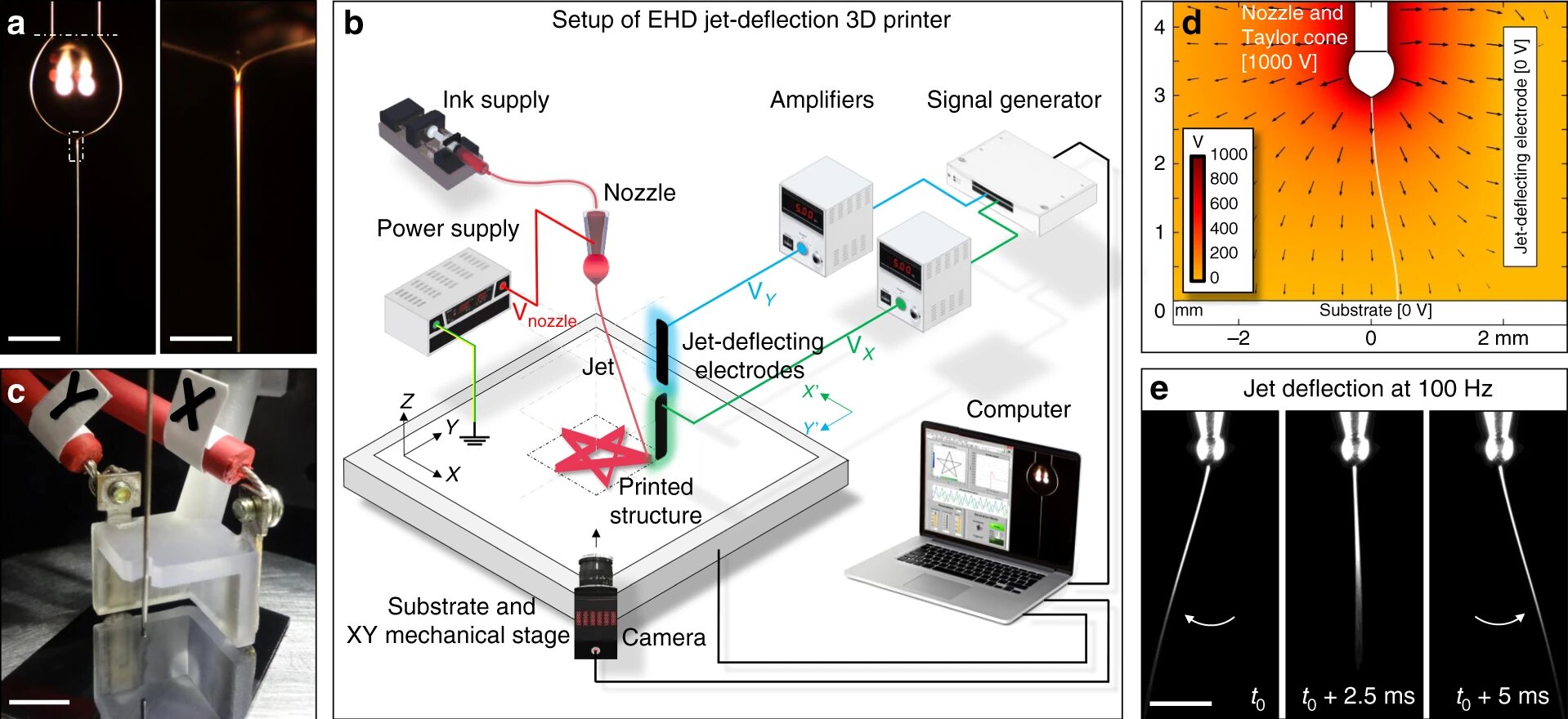Researchers in Spain have devised a method of ultrafast 3D printing with submicrometer features using electrostatic jet deflection technology.
As discussed in the paper detailing this new technique, the authors explain that they created the electrostatic jet deflection method in order to overcome the limitations of existing additive manufacturing technology in relation to production speed. From their tests, the researchers found that electrostatic jet deflection can 3D print objects with submicrometer features by stacking nanofibers on top of each other at layer-by-layer frequencies as high as 2000 Hz.
The jet speed and layer-by-layer frequencies achieved equates to printing speeds up to 0.5 m s−1 in-plane and 0.4 mm s−1 in the vertical direction, which the researchers state is “three to four orders of magnitude faster than techniques providing equivalent feature sizes.”

Improving 3D printing processes
The researchers first set about describing the benefits provided by additive manufacturing technologies for production today, writing that, “Additive manufacturing has become the new paradigm of distributed production of customized products, providing advantages in terms of geometric freedom of design, material utilization, and lead time reduction.”
Despite this, a number of research has been conducted with the aim of improving existing 3D printing processes. For example, researchers in Austria have explored the necessary improvements that material extrusion‐based additive manufacturing methods (ME-AM/FDM/FFF) need to make in order to “meet the challenges of complex industrial applications.” Other research has looked at examining the effect of fast print speeds in the binder jetting process, particularly in regards to surface roughness and density uniformity.
As is the case with many research papers aiming to improve existing additive manufacturing processes, the authors of the paper discussed here state that there are a number of limitations surrounding current 3D printing technologies, namely production speed, availability and combination of materials, and control over their microstructure and thus functionality. “Additionally,” the authors add, “the cost and complexity of manufacturing equipment that enables producing submicrometer features are prohibitive for a true distributed production.”
In particular, nozzle-based 3D printing technology provides a great example of a process that offers “unmatched versatility” in that it enables the production of objects made from a varying degree of materials, ranging from polymers, to metals, to ceramics, to wood, and even to biological tissues. “Such unmatched material versatility stems from the use of metal or polymer melts or solvent-based inks, which can be formulated to contain any component in the form of ions, molecules, nanoparticles, or even living cells,” explain the researchers.
However, current nozzle-based 3D printing technologies are relatively slow, with limited printing resolutions because the width of the printed lines correlates with that of the nozzle aperture, which are typically above several tens of micrometers. Even when using smaller nozzle apertures, the process is then prone to frequent clogging and high viscous losses.
Using electrostatic jet deflection technology
An electrohydrodynamic (EHD) jetting strategy, the authors propose, is uniquely suited for high resolution 3D printing compared to other nozzle-based 3D printing methods, as demonstrated by researchers at ETH Zürich in 2019. “EHD jetting allows printing submicrometer features with no risk of nozzle clogging, as it enables the generation of nanometer-sized jets from wide nozzle apertures using a great variety of inks, with viscosities ranging over several orders of magnitude.”

However, EHD jetting has not been developed in full for widespread use as the electrified jets are too fast to be precisely collected by the mechanical stages, which are comparably slow. “Current systems based on EHD jetting use mechanical stages to locate the material on the printing substrate. However, mechanical stages can only match the huge speeds of the electrified jets in long straight lines, but cannot attain the giant accelerations that are needed to sustain such speeds while printing small complex patterns,” add the authors.
To overcome the limitations of the EHD jetting process, the researchers propose using electrodes for modification of the electric field. Using a traditional EHD printer, the researchers placed electrodes located around the jet and controlled their voltage to continuously adjust its trajectory with lateral accelerations up to 106 m s−2. This enables ultrafast electrostatic deflecting of the jet, allowing nanofibers to be stacked in order to print 3D objects with submicrometer features.

From their tests, the researchers were able to 3D print objects via layer-by-layer deposition of material with heights up to 100 µm, as well as very high aspect ratios and high speeds: “The fast jet and these high layer-by-layer frequencies translated into printing speeds up to 0.5 m s−1 in-plane and 0.4 mm s−1 off-plane, i.e., in the vertical direction, three to four orders of magnitude faster than achievable by extrusion and drop-on-demand EHD techniques when producing equivalent feature sizes.”
Concluding the paper, the researchers state that the advantages of EHD jet deflection printing, as demonstrated in their paper, can potentially bring the technology closer towards ultrafast additive micromanufacturing of 3D objects. The paper, “Ultrafast 3D printing with submicrometer features using electrostatic jet deflection,” is written by Ievgenii Liashenko, Joan Rosell-Llompart, and Andreu Cabot. It is published in Nature Communications.
The nominations for the 2020 3D Printing Industry Awards are now open. Who do you think should make the shortlists for this year’s show? Have your say now.
Subscribe to the 3D Printing Industry newsletter for the latest news in additive manufacturing. You can also stay connected by following us on Twitter and liking us on Facebook.
Looking for a career in additive manufacturing? Visit 3D Printing Jobs for a selection of roles in the industry.
Featured image shows optical photographs of the nozzle, ink drop (below dotted line), Taylor cone, and the electrified jet generated by applying 1000 V between the nozzle and a printing substrate (not shown). Photo via Nature Communications.


